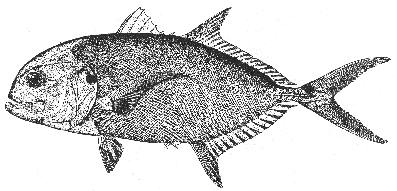Crevalle Caranx hippos (Linnaeus) 1766
JACK
[Jordan and Evermann, 1896-1900, p. 920]
Description—
The presence of a well-developed first dorsal fin (8 spines) combined with an anal (about 17 rays, preceded by 2 short detached spmes) nearly as long as the second dorsal (about 20 rays), but no detached finlets, separates this particular jack from all other pompanos known from the Gulf, except the goggle-eyed scad (p. 377), hardtail (p. 376), and the saurel (p. 377). Its arched lateral line and the presence of (usually) two pairs of small but plainly visible canine teeth in the lower jaw distinguish it from the goggle eye; its naked breast and its canine teeth from the hardtail and saurel. The dorsal profile, too, of the head of the crevalle (fig. 200) is characteristic, and the long scimitar-shaped pectoral fins are a convenient field mark to separate it and other members of its immediate tribe,[64] from the pilotfish, rudderfish, and mackerel scad, in which the pectorals are short and blunter. We need only call attention further to its deeply forked tail; to the row of keeled shields along, either side of its caudal peduncle; to its flattened oblong form (body [page 376] only about two and one-half times as long as deep, but with caudal peduncle as slender as that of a mackerel), and to its blunt head.
Color—
Greenish or greenish bronze above with golden sides; silvery below, sometimes with yellow blotches. There is a large black blotch on the gill cover, a fainter dark spot on the lower rays of the pectorals (in adults), and a black blotch in their axils. The fins are more or less yellowish; the edge of the dorsals is black. Very young fish have 5 or 6 dark cross-bars.
Size—
Maximum recorded weight 36 pounds.
General range—
Warm seas; abundant on both coasts of America; northward as a stray to the outer coast of Nova Scotia;[65] also among the East Indies.
Occurrence in the Gulf of Maine—
We know of only two records of this southern fish from our Gulf, one specimen picked up on Lynn Beach on the shore of Massachusetts Bay during the summer of 1847, and a second taken at Provincetown in 1933.[66] But it is a regular summer visitor at Woods Hole though it is not common there.
Commercial importance—
A famous game fish, but of minor commercial importance.
[64] The yellow tail (Chloroscombrus chrysurus), another species in this group straggles northward at times and, sometime, may be taken within the Gulf of Maine. It may be distinguished from the crevalle, hardtall, saurel, and big-eyed scad by the fact that its lateral line is wholly unarmed, whereas in these species it is armed with bony plates, along part of its length at least.
[65] Reported near Halifax, Nova Scotia, by Vladykov (Proc. Nova Scotian Inst. Sci., vol. 19, 1935, p. 4).
[66] Reported by MacCoy, Bull. 70, Boston Soc. Nat. History, 1934, p. 6.
